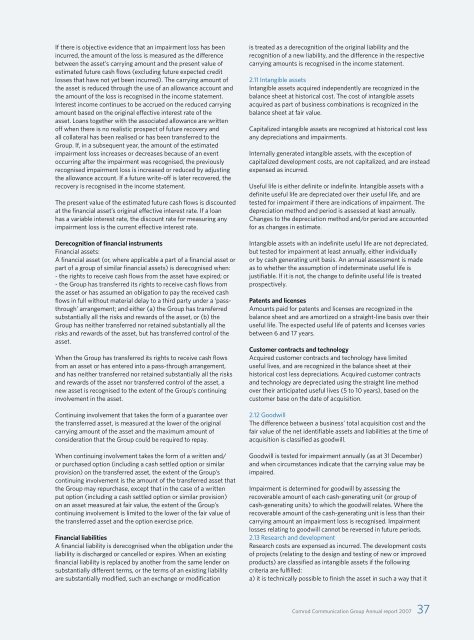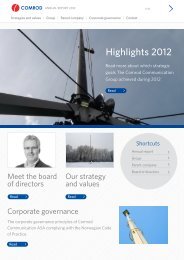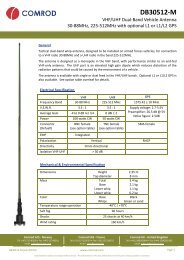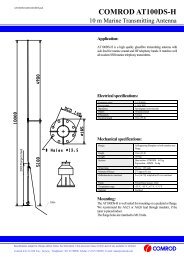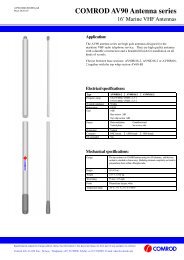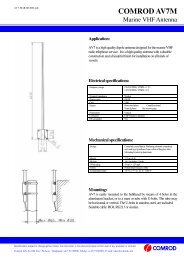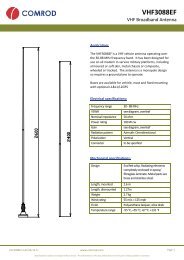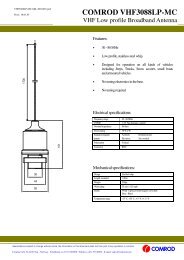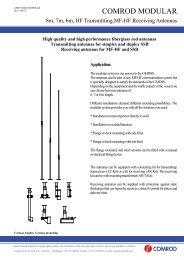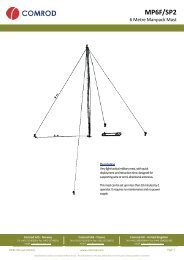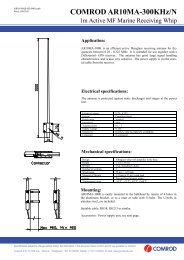Annual report 2008 - Comrod
Annual report 2008 - Comrod
Annual report 2008 - Comrod
- No tags were found...
You also want an ePaper? Increase the reach of your titles
YUMPU automatically turns print PDFs into web optimized ePapers that Google loves.
If there is objective evidence that an impairment loss has beenincurred, the amount of the loss is measured as the differencebetween the asset’s carrying amount and the present value ofestimated future cash flows (excluding future expected creditlosses that have not yet been incurred). The carrying amount ofthe asset is reduced through the use of an allowance account andthe amount of the loss is recognised in the income statement.Interest income continues to be accrued on the reduced carryingamount based on the original effective interest rate of theasset. Loans together with the associated allowance are writtenoff when there is no realistic prospect of future recovery andall collateral has been realised or has been transferred to theGroup. If, in a subsequent year, the amount of the estimatedimpairment loss increases or decreases because of an eventoccurring after the impairment was recognised, the previouslyrecognised impairment loss is increased or reduced by adjustingthe allowance account. If a future write-off is later recovered, therecovery is recognised in the income statement.The present value of the estimated future cash flows is discountedat the financial asset’s original effective interest rate. If a loanhas a variable interest rate, the discount rate for measuring anyimpairment loss is the current effective interest rate.Derecognition of financial instrumentsFinancial assets:A financial asset (or, where applicable a part of a financial asset orpart of a group of similar financial assets) is derecognised when:- the rights to receive cash flows from the asset have expired; or- the Group has transferred its rights to receive cash flows fromthe asset or has assumed an obligation to pay the received cashflows in full without material delay to a third party under a ‘passthrough’arrangement; and either (a) the Group has transferredsubstantially all the risks and rewards of the asset, or (b) theGroup has neither transferred nor retained substantially all therisks and rewards of the asset, but has transferred control of theasset.When the Group has transferred its rights to receive cash flowsfrom an asset or has entered into a pass-through arrangement,and has neither transferred nor retained substantially all the risksand rewards of the asset nor transferred control of the asset, anew asset is recognised to the extent of the Group’s continuinginvolvement in the asset.Continuing involvement that takes the form of a guarantee overthe transferred asset, is measured at the lower of the originalcarrying amount of the asset and the maximum amount ofconsideration that the Group could be required to repay.When continuing involvement takes the form of a written and/or purchased option (including a cash settled option or similarprovision) on the transferred asset, the extent of the Group’scontinuing involvement is the amount of the transferred asset thatthe Group may repurchase, except that in the case of a writtenput option (including a cash settled option or similar provision)on an asset measured at fair value, the extent of the Group’scontinuing involvement is limited to the lower of the fair value ofthe transferred asset and the option exercise price.Financial liabilitiesA financial liability is derecognised when the obligation under theliability is discharged or cancelled or expires. When an existingfinancial liability is replaced by another from the same lender onsubstantially different terms, or the terms of an existing liabilityare substantially modified, such an exchange or modificationis treated as a derecognition of the original liability and therecognition of a new liability, and the difference in the respectivecarrying amounts is recognised in the income statement.2.11 Intangible assetsIntangible assets acquired independently are recognized in thebalance sheet at historical cost. The cost of intangible assetsacquired as part of business combinations is recognized in thebalance sheet at fair value.Capitalized intangible assets are recognized at historical cost lessany depreciations and impairments.Internally generated intangible assets, with the exception ofcapitalized development costs, are not capitalized, and are insteadexpensed as incurred.Useful life is either definite or indefinite. Intangible assets with adefinite useful life are depreciated over their useful life, and aretested for impairment if there are indications of impairment. Thedepreciation method and period is assessed at least annually.Changes to the depreciation method and/or period are accountedfor as changes in estimate.Intangible assets with an indefinite useful life are not depreciated,but tested for impairment at least annually, either individuallyor by cash generating unit basis. An annual assessment is madeas to whether the assumption of indeterminate useful life isjustifiable. If it is not, the change to definite useful life is treatedprospectively.Patents and licensesAmounts paid for patents and licenses are recognized in thebalance sheet and are amortized on a straight-line basis over theiruseful life. The expected useful life of patents and licenses variesbetween 6 and 17 years.Customer contracts and technologyAcquired customer contracts and technology have limiteduseful lives, and are recognized in the balance sheet at theirhistorical cost less depreciations. Acquired customer contractsand technology are depreciated using the straight line methodover their anticipated useful lives (5 to 10 years), based on thecustomer base on the date of acquisition.2.12 GoodwillThe difference between a business’ total acquisition cost and thefair value of the net identifiable assets and liabilities at the time ofacquisition is classified as goodwill.Goodwill is tested for impairment annually (as at 31 December)and when circumstances indicate that the carrying value may beimpaired.Impairment is determined for goodwill by assessing therecoverable amount of each cash-generating unit (or group ofcash-generating units) to which the goodwill relates. Where therecoverable amount of the cash-generating unit is less than theircarrying amount an impairment loss is recognised. Impairmentlosses relating to goodwill cannot be reversed in future periods.2.13 Research and developmentResearch costs are expensed as incurred. The development costsof projects (relating to the design and testing of new or improvedproducts) are classified as intangible assets if the followingcriteria are fulfilled:a) it is technically possible to finish the asset in such a way that it<strong>Comrod</strong> Communication Group <strong>Annual</strong> <strong>report</strong> 2007 37


